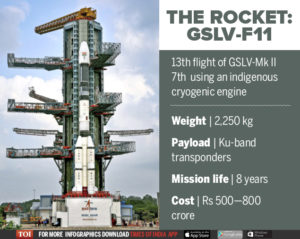Applications of GSAT-7A
What is the News?
Military communication satellite GSAT-7A, is expected to add a new space-based dimension to the way Indian Air Force interlinks, operates and communicates with its aircraft as they fly and with command centres on ground.
Although all Indian communication satellites offer capacity to the armed forces, GSAT-7A will be the first one built primarily for the IAF to qualitatively unify its assets and improve combined, common intelligence during operations and it will also support aerial activities of the Army and the Navy where required.
About GSAT-7A
 GSLV-F11 successfully launched GSAT-7A, ISRO’s 39th communication satellite from the Second Launch Pad (SLP) of Satish Dhawan Space Centre SHAR, Sriharikota.
GSLV-F11 successfully launched GSAT-7A, ISRO’s 39th communication satellite from the Second Launch Pad (SLP) of Satish Dhawan Space Centre SHAR, Sriharikota.- GSAT-7A is an advanced military communications satellite meant primarily for the Indian Air Force with Indian Army using 30% of capacity.
- It is the heaviest satellite being launched by GSLV with an indigenously developed cryogenic stage.
- The GSAT-7A is expected to have the Ku-band transponders and two deployable solar arrays onboard.
- GSAT-7A is similar to Indian navy’s GSAT-7.
About GSLV-F11
- GSLV-F11 is the 13th flight of India’s Geosynchronous Satellite Launch Vehicle (GSLV) and its 7th flight with indigenous Cryogenic Upper Stage (CUS).
- It is ISRO’s fourth generation launch vehicle with three stages.
Applications of GSAT-7A
- GSAT-7A will enable IAF to interlink different ground radar stations, ground airbase Real-time Control System, Airborne early warning and control (AWACS) etc.,.
- The satellite is being dubbed as ‘angry bird’, is likely to enhance the range of communication and also aid in aircraft to aircraft communication.
- It will help the Indian Navy reduce the reliance on on-ground control stations and take satellite-control of military unmanned aerial vehicles (UAV) which should help boost the range and endurance of the UAVs.
By: Sai Eswar

 GSLV-F11 successfully launched GSAT-7A, ISRO’s 39th communication satellite from the Second Launch Pad (SLP) of Satish Dhawan Space Centre SHAR, Sriharikota.
GSLV-F11 successfully launched GSAT-7A, ISRO’s 39th communication satellite from the Second Launch Pad (SLP) of Satish Dhawan Space Centre SHAR, Sriharikota.